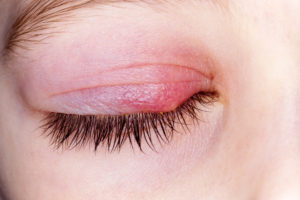 Styes are something almost everyone has experienced in their lifetime. This condition cause a reddened area along the eye lid that is swollen and could be itchy. The area gets even more swollen in the morning and may even be painful. Yep, you’re experiencing a sty.
Styes are something almost everyone has experienced in their lifetime. This condition cause a reddened area along the eye lid that is swollen and could be itchy. The area gets even more swollen in the morning and may even be painful. Yep, you’re experiencing a sty.
A sty is an infection, generally in a hair follicle that is caused by a bacterial infection. After a few days there can be a white head that forms and pus appears in the area. The individual may also feel as if there is something gritty in the eye and there may be more tears than usual as the body attempts to soothe the eye by producing more tears from the lacrimal glands located just above the orbit of the eye.
Where Do Styes Develop?
The sty can actually come out on the outside of the eye lid, in which case you will see the common white or yellow head that forms. In the other case it forms on the inside of the lid which prevents the common head from forming.
The bacteria that causes a sty is usually Staphlococcus infection. This is a strain of bacteria that commonly lives on our skin surface. Our bodies are actually covered with billions of friendly bacteria that coexist with us. These bacteria don’t often cause trouble unless our immune systems are compromised and we are no longer able to fight infections easily.
Pink Eye or a Sty?
Styes are different than pink eye because pink eye infects the conjunctiva of the eye or the membrane that covers the eye lid and the sty is an infection in one or two hair follicles. Initially they may appear quite the same but with a sty you’ll notice that the lid (either lower or upper) becomes swollen and red in one place while with Pink Eye the eye becomes irritated and pink or red in the white of the eye and there isn’t a localized swelling of the lid but a more generalized swelling.
Tips to Survive Your Sty
Don’t Spread the Infection. To avoid spreading the infection from one to the other eye:
- Don’t touch the eye and when you do wash your hands often.
- Dry the hands with a clean paper towel to keep the bacteria from spreading.
Speed Healing. You can help to decrease the pain and discomfort, as well as speed healing:
- Use a warm wet compress over the eye four times a day for 10 minutes each.
This will help the sty to form quickly and break quickly, thus speeding the healing of the infection and decreasing the pain and discomfort.
Don’t Pop the Pimple. Once you see a white or yellow head to the sty do not press it or rupture it. It will break on its own. Use a clean, warm wet wash cloth to clean the area and to carefully remove the pus once it has broken open.
When to Call the Doctor for Your Sty
You don’t usually have to call the doctor to treat a sty. However, you should call your doctor if your vision changes, if the eye becomes painful or if the sty returns quickly after it appears to have healed. If you develop a temperature at the same time that you have a sty you should see your doctor because this can be a symptom of a far more serious infection, cellulitis, that can look like a sty.
Sometimes a sty doesn’t resolve on its own and you have to see the doctor. They may prescribe a local antibiotic to treat the infection and will usually continue to recommend a warm wet wash cloth to help speed healing.
An internal sty, or one that forms under the lid, commonly has more problems healing than the ones that are on the outside of the lid.
RESOURCES
-
Disabled World: Eye Stye Cures and Causes – http://www.disabled-world.com/disability/types/vision/eye-sty.php
-
EyeSmart: What are Chalzia and Styes – http://www.geteyesmart.org/eyesmart/diseases/chalazion-stye.cfm
-
KidsHealth: Styes – http://kidshealth.org/teen/diseases_conditions/sight/stye.html
-
PubMed health: Eyelid Bump – http://www.ncbi.nlm.nih.gov/pubmedhealth/PMH0002004/
-
LocalHarvest: Stye Eye Compress – http://www.localharvest.org/stye-eye-compress-C6573
-
Columbia: Stye – http://www.cumc.columbia.edu/student/health/pdf/R-S/Stye.pdf

